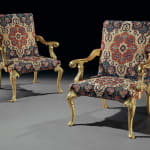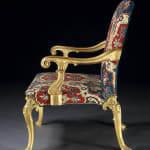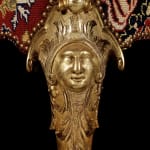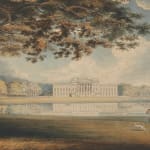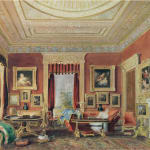Seating
THE WANSTEAD HOUSE GILT-GESSO ARMCHAIRS ATTRIBUTED TO JAMES MOORE
W: 81.3cm
D: 74.9cm
Further images
Provenance
Sir Richard Child (1680 - 1750), 1st Viscount Castlemaine, later 1st Earl Tylney, twelve chairs for Wanstead House, Essex
By decent to Sir James Tylney-Long (1736 - 94), 7th Bt. and his wife Lady Catherine Windsor
Their daughter, Catherine, married William Pole-Tylney-Long-Wellesley, 4th Earl of Mornington
The set sold in pairs from Wanstead House, 10 June 1822 and 31 following days, seventeenth day, lots 23 and 27, the present chairs, acquired by ‘Lane’ for £27.6 and £26.15.6, the remaining eight acquired by Philip John Miles for Leigh Court, Somerset
Given to William, 6th Baron Monson (d. 1862) by ‘Anna’ Wakelin for Burton Hall, possibly mid-1850s; by descent until sold 2015
Private Collection: West Coast, USA
Publications
An Inventory of the Household Furniture, Linen, China, Glass, Books, Wines and Effects of the Late Sir James Tylney Long Bart. deceased at Wanstead House in the County of Essex appraised Feb’y 23 1795 & Following Days, in the ‘Dressing Room’ of the ‘Crimson Bed Chamber’
A. Denney, Burton Hall, privately published, 1950, two of the chairs in the Stone Drawing Room
A Rare and Highly Important pair of Early 18th Century Giltwood Armchairs.
Attributed to James Moore and Commissioned for Wanstead House.
Overview and Design
This exceptional pair of early 18th-century English giltwood armchairs exemplifies the monumental ambition and refined craftsmanship of the early Georgian period. The chairs are defined by their bold architectural form, featuring robust scrolling arms, richly carved cabriole legs headed by expressive female mask motifs, and ending in elegant pad feet. The arms and legs are adorned with intricate acanthus-leaf carving, while the mask mounts—commonly referred to as “Indian” heads—introduce an exotic touch, reflecting both the artistic curiosity and commercial reach of the period.
Original Tapestry Upholstery
The upholstery is an equally remarkable survival: original early 18th-century tapestry needlework, vibrantly woven in a bold, Eastern-inspired pattern of crimson, navy, and ivory. Likely echoing Ottoman or Persian carpet designs, this textile would have resonated with Georgian tastes for the exotic and the luxurious. The use of such a complex and costly fabric underscored the status of the chairs’ owner and placed them firmly within the broader context of global trade, where the acquisition and display of rare goods formed a key part of elite identity.
Historical Provenance: Wanstead House
The significance of these chairs is difficult to overstate. They were originally part of the furnishings of Wanstead House in Essex—one of the most ambitious and architecturally significant great houses built in early 18th-century Britain. Commissioned between 1713 and 1717 by Sir Richard Child, later created Earl Tylney, Wanstead House was conceived as a domestic palace on a scale to rival the royal residences of the day. It emerged in the immediate aftermath of the 1707 Act of Union and stood as an architectural expression of Britain’s new national identity—confident, ordered, and classically rooted.
Architecture and Ideology: The Neo-Palladian Context
The house was designed by Colen Campbell, the Scottish architect and theorist whose work helped define and promote the Neo-Palladian style in Britain. Rejecting the florid theatricality of the Baroque—associated with continental absolutism and Catholic Europe—Campbell’s vision for Wanstead was one of classical symmetry, proportion, and intellectual restraint. The house featured prominently in Campbell’s seminal publication, Vitruvius Britannicus (1715–1725), a visual manifesto of British architectural modernity that helped cement Neo-Palladianism as the dominant idiom of the Georgian period.
James Moore and Royal Patronage
The present chairs are entirely in keeping with the ideological and aesthetic aspirations of Wanstead. The craftsmanship is of the highest order and is characteristic of the workshop of James Moore, the most celebrated cabinetmaker of the early Georgian court. Moore, who began his royal commissions under Queen Anne and was formally appointed Royal Cabinetmaker under George I in the early 1720s, was widely favoured by leading aristocratic patrons. His work at Blenheim Palace, Windsor Castle, and Hampton Court is marked by a fusion of classical clarity with opulent detailing—an approach that resonates strongly in the present pair.
Design Motifs and Symbolism
Moore’s furniture often features bold architectural profiles with refined surface decoration. The distinctive mask mounts, including the “Indian” heads seen here, are a hallmark of his mature style. These masks not only add a sculptural flourish but may carry symbolic weight. The Child family, whose fortune was closely tied to the East India Company, may have included such motifs to subtly reflect their global connections and mercantile legacy—particularly that of Sir Josiah Child, one of the Company’s most influential directors.
Cultural Resonance of the Tapestry Upholstery
The tapestry upholstery further reinforces this narrative of cultural and commercial convergence. Its pattern—reminiscent of imported Eastern carpets—suggests a conscious engagement with the aesthetics of empire and the allure of the exotic. In this context, the chairs functioned not only as expressions of wealth and taste but as artefacts of Britain’s expanding imperial imagination.
Loss and Survival: The Legacy of Wanstead House
The eventual fate of Wanstead House only heightens the poignancy and historical importance of these chairs. After the Tylney family fortunes declined, the house was tragically demolished in 1822, and its contents sold in a landmark auction that marked the end of a chapter in English cultural history. Very few pieces from Wanstead have survived—and fewer still of this calibre. These chairs are among the rare physical remnants of a vanished architectural masterpiece.
Conclusion: A Testament to Early Georgian Grandeur
In their form, decoration, and historical associations, these chairs stand as powerful testaments to the ambitions of early Georgian Britain—ambitions rooted in classical ideals, global vision, and the cultivation of a distinctly British decorative language. They embody the creative brilliance of James Moore and the cultural aspirations of the patrons who helped shape the modern British interior.





